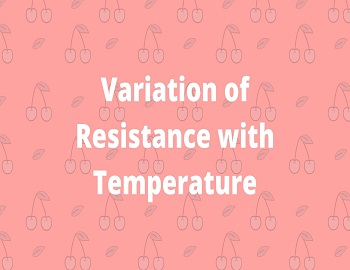Variation of Resistance with Temperature:
We know, the resistance of the metallic conductor is given by-
| R = ml/ne2τA |
For a given conductor,
| R ∝ 1/τ ………………..(I) |
When the temperature of the metal conductor is raised, the atoms/ions of the metal vibrate with greater frequency and hence relaxation time ‘τ’ decreases and from (I), we can conclude that the resistance of the conductor increases. Hence when the temperature of the metal conductor is raised, its resistance increases.
The resistance Rt of the conductor at temperature t°c is given by-
| Rt = Ro (1 + αt) |
Where ‘Ro‘ is the resistance of the conductor at 0°C and ‘α’ is the temperature coefficient of resistance.
| ⇒ Rt = Ro + Ro αt ⇒ Rt – Ro = Ro αt ⇒ α = (Rt – Ro)/Rot = Increase in Resistance/Original resistance x rise of temperature |
Hence, the temperature coefficient of resistance is defined as the increase in resistance per unit of original resistance per degree rise of temperature. The S.I. unit of ‘α’ is K-1 or °C-1.
For Metals- The value of α is positive i.e. the resistance of the metal increases with temperature.
For Insulators and Semiconductors- The value of α is negative i.e. the resistance decreases with the rise of temperature.
For Alloys- The value of α is very very small. Due to high resistivity and low-temperature coefficient of resistance, these alloys are used for making standard resistance coils.









Comments (No)